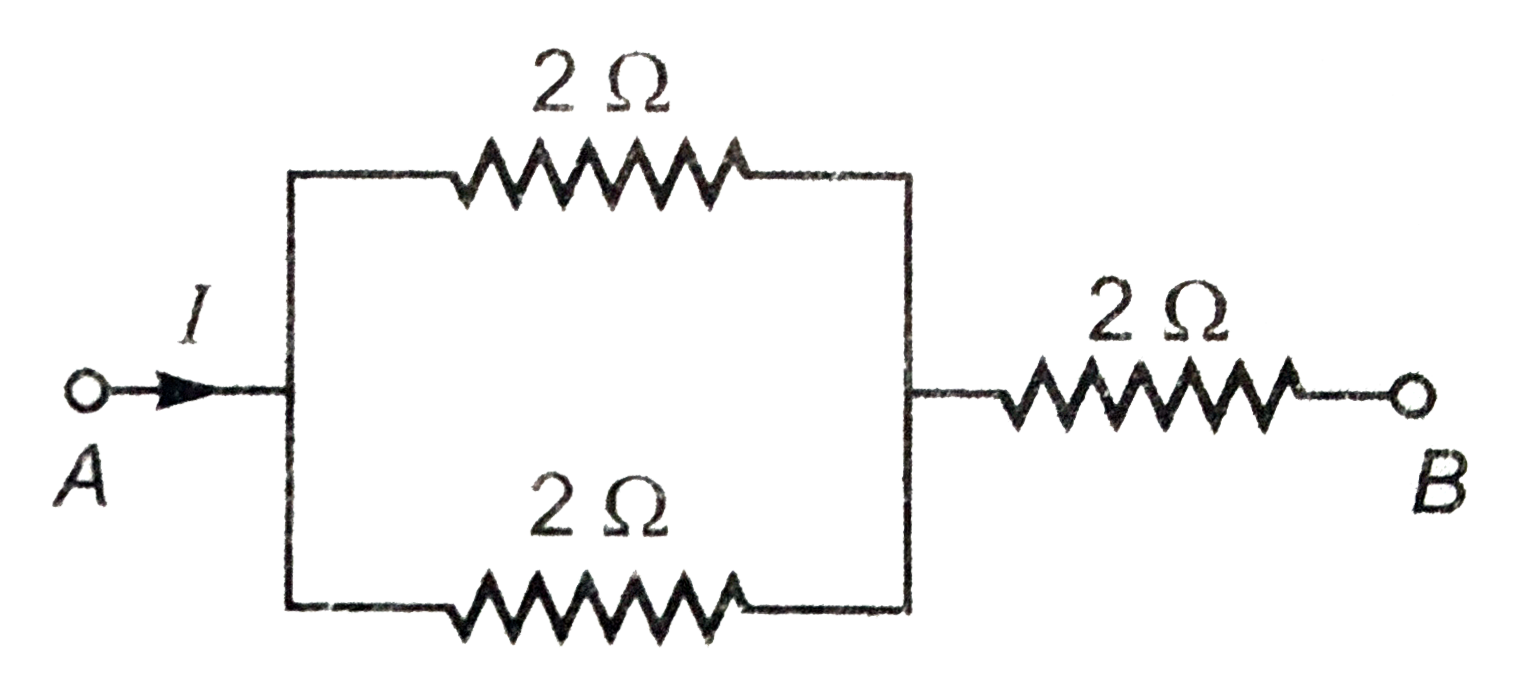The 'maximum' power rating of each resistor (2Ω) in the given circuit is 18 W (otherwise it would melt).
What is the maximum power rating of the whole current?
(ii) Equivalent resistance of the combination
 Solution in Bengali
Solution in Bengali
Step by step video & image solution for The 'maximum' power rating of each resistor (2Omega) in the given circuit is 18 W (otherwise it would melt). What is the maximum power rating of the whole current? (ii) Equivalent resistance of the combination by Physics experts to help you in doubts & scoring excellent marks in Class 12 exams.
Updated on:21/07/2023Topper's Solved these Questions
Similar Questions
A current of one ampere is flowing through a wire. Calculate the number of electrons flowing through the cross-section of the wire per second?
View SolutionThree resistors having resistances of 1.60 Omega, 2.40 Omega and 4.80 Omega are connected in parallel to a 28.0 V battery that has negligible internal resistance. Find (a) the equivalent resistance of the combination. (b) the current in each resistor. (c) the total current through the battery. (d) the voltage across each resistor. (e) the power dissipated in each resistor. (f) which resistor dissipates the maximum power the one with the greatest resistance or the least resistance? Explain why this should be.
View SolutionEach of three resistors in fig. 7.12 has a resistance of 2Ω and can dissipate a maximum of 18W without becoming excessively heated. Find the maximum power the circuit can dissipate.

View SolutionIn the given circuit if the internal resistance of the batteries are negligible, then for what value of resistance R(inΩ) will the thermal power generated in it be maximum.

View SolutionThe resistance of each of the three wires joined as shown in figure is 4 Omega and each one can have a maximum power of 20 watt (otherwise it will melt). What maximum power will the whole circuit dissipate ?
View SolutionThe maximum power rating of a 20Ω resistor is 2.0 kW. [That is, this is the maximum power the resistor can dissipate (as heat) without melting or changing in some other undersirable way]. Would you connect this resistor directly across a 300 V d.c. source of negligible internal resistance ? Explain your answer.
View Solution(a) Given n resistors each of resistance R . How will you combine them to get the (i) maximum (ii) minimum effective resistance ? What is the ratio of the maximum to minimum resistance ? (b) Given the resistances of 1 Omega, 2 Omega, 3 Omega , how will you combine them to get an equivalent resistance of (i) (11//3)Omega (ii) (11//5)Omega (iii) 6 Omega (iv) (6//11) Omega ? (c) Determine the equivalent resistance of networks shown in Figure.
View SolutionIn the circuit shown in Fig.6.1, each of the three resistors of 4Omega can have a maximum power of 20W (otherwise it will melt). What maximum power can the whole circuit take?
View SolutionIn the following figures, each of the three resistances, the rating of 24 W and resistance of 6Ω. Find the maximum power rating of the circuit.

View Solutionदिये गये तीन प्रतिरोधों में प्रत्येक का प्रतिरोध 4 Ω है तथा प्रत्येक को अधिकतम 64 वाट तक विघुतशक्ति दी जा सकती है । पूरा परिपथ अधिकतम कितनी शक्ति ले सकता है?
View Solutionसंलग्न चित्र में जुड़े तीन प्रतिरोध - तारो में प्रत्येक का प्रतिरोध 2Ω है तथा प्रत्येक को अधिकतम 18 वाट तक वैधुत शक्ति दी जा सकती है (वरना वह पिघले जाएगा ) । पूरा परिपथ कितनी अधिकतम शक्ति ले सकता है ?

View Solution10Ω के तीन समान प्रतिरोध R1,R2 और R3, चित्र II.71 में दिखाए अनुसार जोड़े जाते हैं। प्रत्येक प्रतिरोध द्वारा खपत की गई अधिकतम शक्ति 20 W है। संयोजन द्वारा खपत की गई अधिकतम शक्ति है

View Solution(a) Given n resistors each of resistance R . How will you combine them to get the (i) maximum (ii) minimum effective resistance ? What is the ratio of the maximum to minimum resistance ? (b) Given the resistances of 1 Omega, 2 Omega, 3 Omega , how will you combine them to get an equivalent resistance of (i) (11//3)Omega (ii) (11//5)Omega (iii) 6 Omega (iv) (6//11) Omega ? (c) Determine the equivalent resistance of networks shown in Figure.
View SolutionThree 2Ω resistors, A, B and C, are connected as shown in figure. Each of them dissipates energy and can withstand a maximum power of 18 W without melting. Find the maximum current that can flow through the three resistors?

View SolutionEach of three resistors in figure has a resistance of 2.4Ω and can dissipate a maximum of 36 W without becoming excessively heated. What is the maximum power the circuit can dissipate?

View SolutionThree resistors having resistances of 1.60 Omega, 2.40 Omega and 4.80 Omega are connected in parallel to a 28.0 V battery that has negligible internal resistance. Find (a) the equivalent resistance of the combination. (b) the current in each resistor. (c) the total current through the battery. (d) the voltage across each resistor. (e) the power dissipated in each resistor. (f) which resistor dissipates the maximum power the one with the greatest resistance or the least resistance? Explain why this should be.
View Solution
